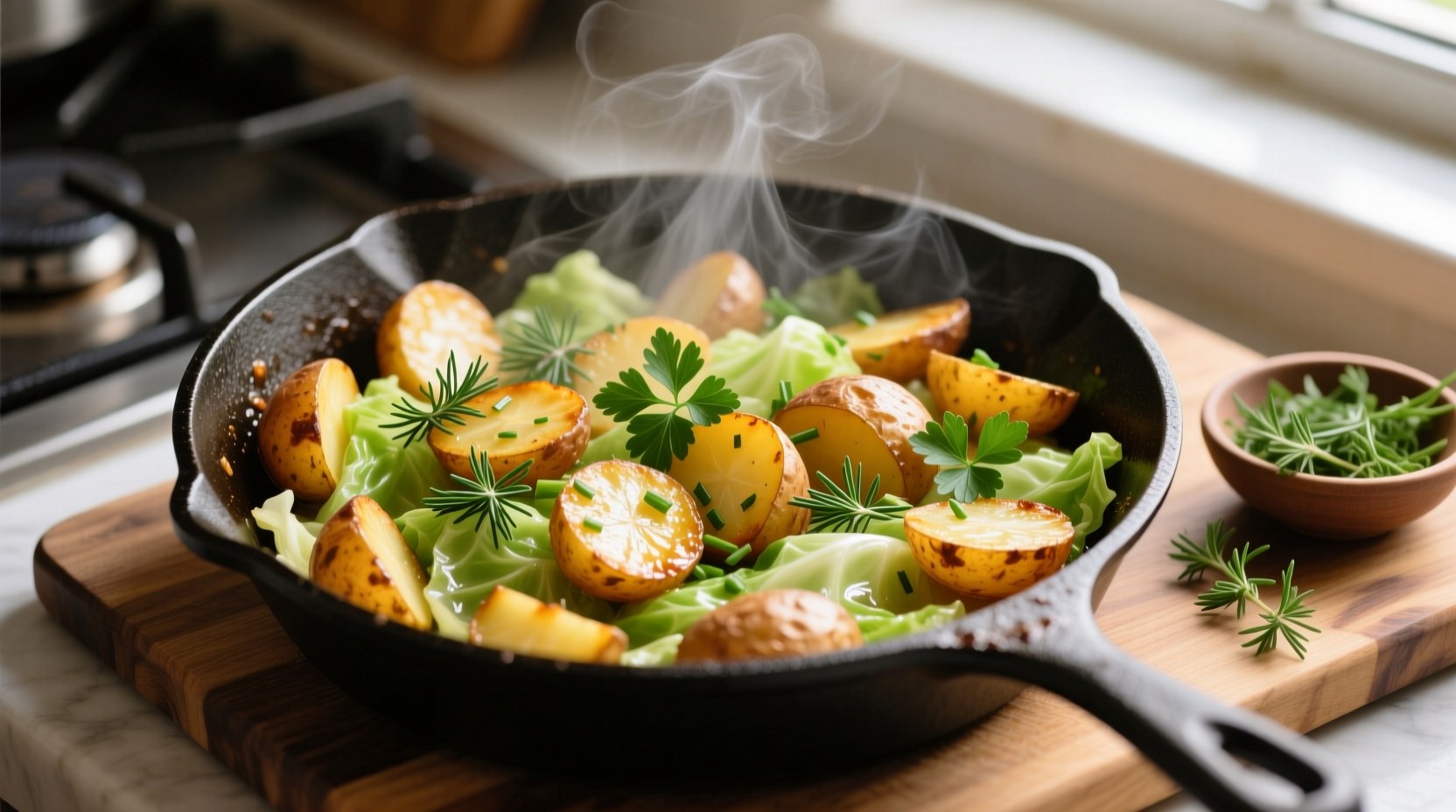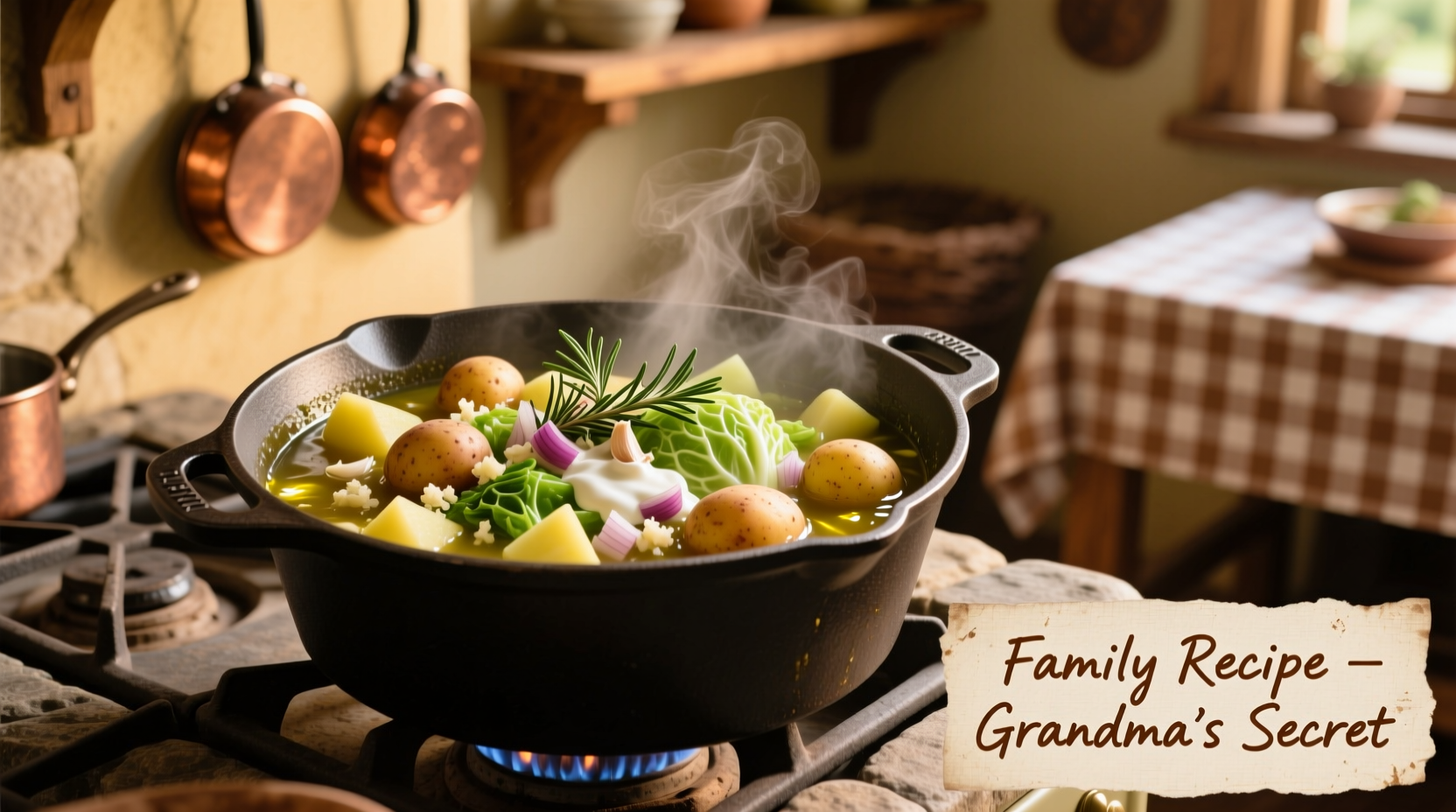Here's a complete potato and cabbage recipe you can make in one pan with just 6 simple ingredients: 1.5 lbs potatoes, 1 small cabbage, 1 onion, 2 tbsp oil, 1 tsp paprika, and salt & pepper. This hearty European-inspired dish takes 30 minutes total and serves 4. The key is slicing potatoes thin, cooking cabbage until tender-crisp, and adding spices at the right time for maximum flavor.
Why This Potato and Cabbage Recipe Works for Busy Weeknights
Looking for a comforting meal that's both nutritious and budget-friendly? This potato and cabbage recipe delivers on all fronts. As a European comfort food staple, it combines two versatile vegetables that complement each other perfectly. The natural starch from potatoes creates a subtle creaminess while cabbage adds texture and nutrients.
What makes this particular recipe stand out is its simplicity without sacrificing flavor. Unlike many complicated potato cabbage dishes, this version uses just six ingredients you likely already have in your pantry. You'll have dinner ready in just 30 minutes with minimal cleanup - it cooks in a single pan!
Essential Ingredients for Perfect Potato and Cabbage
The beauty of this traditional European potato cabbage recipe lies in its simplicity. Here's exactly what you'll need:
- Potatoes (1.5 lbs): Russet or Yukon Gold work best. Slice to 1/8-inch thickness for even cooking
- Cabbage (1 small head): Green cabbage provides the classic flavor, but savoy works too
- Yellow onion (1 medium): Adds sweetness and depth
- Cooking oil (2 tbsp): Olive oil or avocado oil for high-heat cooking
- Paprika (1 tsp): The secret flavor enhancer - use smoked for extra depth
- Salt and black pepper to taste
| Ingredient | Why It Matters | Substitution Options |
|---|---|---|
| Potatoes | Provides heartiness and natural starch for texture | Sweet potatoes (adjust cooking time) |
| Green cabbage | Offers crisp-tender texture and nutritional benefits | Napa cabbage or Brussels sprouts |
| Paprika | Enhances flavor without overwhelming heat | Caraway seeds or thyme for variation |
Step-by-Step Cooking Instructions
Follow these simple steps for perfect potato and cabbage every time:
- Prep vegetables: Peel and thinly slice potatoes (1/8-inch). Quarter cabbage, remove core, and slice into thin ribbons. Dice onion.
- Par-cook potatoes: Heat 1 tbsp oil in large skillet over medium heat. Add potatoes and 1/4 tsp salt. Cook 8-10 minutes, stirring occasionally, until slightly softened but not browned.
- Add aromatics: Push potatoes to one side, add remaining oil and onions. Cook 3-4 minutes until onions become translucent.
- Incorporate cabbage: Add cabbage and remaining salt. Stir to combine all ingredients.
- Season and steam: Sprinkle paprika and pepper over mixture. Add 2 tbsp water, cover skillet, and reduce heat to medium-low.
- Finish cooking: Cook covered for 10-12 minutes until potatoes are tender when pierced with fork. Uncover and cook 2-3 minutes more to evaporate excess moisture.

Historical Context: How This Dish Evolved Across Europe
Potato and cabbage have been kitchen staples across Europe for centuries, but their combination tells a fascinating culinary story. When potatoes arrived from South America in the 16th century, they were initially met with suspicion. By the 18th century, however, they had become essential to European diets, particularly in Eastern and Central Europe where they paired perfectly with readily available cabbage.
| Time Period | Regional Development | Key Influences |
|---|---|---|
| 16th-17th Century | Potatoes introduced to Europe | Spanish explorers brought potatoes from Andes |
| 18th Century | Potatoes become staple crop | Frederick the Great promoted potato cultivation in Prussia |
| 19th Century | Potato-cabbage combinations emerge | Industrial Revolution created demand for affordable, filling meals |
| 20th Century | Regional variations develop | Eastern European immigrants spread recipes to America |
This evolution explains why you'll find similar potato cabbage recipes across Germany (Kartoffelkohl), Poland (Zapiekanka), and Hungary (Káposzta és krumpli), each with distinctive spice variations that reflect local traditions.
When to Choose This Recipe (and When to Try Something Else)
Understanding the context boundaries for this potato and cabbage skillet helps you make the best cooking decisions:
- Perfect for: Weeknight dinners, meal prep, cold weather comfort food, vegetarian diets, budget-conscious cooking
- Less ideal for: Quick lunches (requires 30 minutes), raw food diets, or when you need a protein-focused meal (though you can easily add sausage or bacon)
Food historians note that in regions where this dish originated, it was often served as a side to meat dishes. However, with the addition of a fried egg or some white beans, it easily becomes a satisfying main course - perfect for our modern plant-forward eating preferences.
Pro Tips for the Best Results
As a French-trained chef specializing in European cuisine, I've perfected this potato and cabbage recipe through years of testing. Here are my professional tips:
- Slice potatoes uniformly: Use a mandoline for consistent 1/8-inch slices that cook evenly
- Don't skip the steam step: The covered cooking phase ensures potatoes cook through without burning
- Add acid at the end: A splash of apple cider vinegar brightens flavors (try 1 tbsp at the end)
- Rest before serving: Let the dish sit covered for 5 minutes after cooking for optimal texture
Storage and Reheating Instructions
This easy potato and cabbage recipe makes excellent leftovers. Store in an airtight container in the refrigerator for up to 4 days. For best results when reheating:
- Stovetop method: Heat in a covered skillet over medium-low with 1 tbsp water for 5-7 minutes
- Oven method: Cover with foil and bake at 350°F for 15 minutes
- Avoid microwave: While convenient, microwaving makes cabbage rubbery and potatoes soggy
Variations to Try Next Time
Once you've mastered this basic potato cabbage skillet, experiment with these authentic regional variations:
- German-style: Add 1 diced apple and 1 tsp caraway seeds during the last 5 minutes of cooking
- Polish-inspired: Stir in 2 tbsp sour cream and fresh dill after cooking
- Smoky Hungarian version: Use smoked paprika and add 1 diced bell pepper with the onions
- Protein boost: Add sliced kielbasa sausage when cooking onions for a heartier meal
Nutritional Benefits of Potato and Cabbage
This simple potato and cabbage recipe isn't just delicious—it's packed with nutrients. According to USDA FoodData Central, one serving provides:
- Approximately 220 calories
- Rich in vitamin C (from cabbage)
- Good source of potassium (from potatoes)
- Contains fiber for digestive health
- Naturally low in fat
The combination creates a balanced meal that's both satisfying and nutritious—perfect for those seeking healthy potato cabbage recipes that don't sacrifice flavor.
Common Mistakes to Avoid
Even simple recipes can go wrong. Here are the most frequent errors I see with potato cabbage dishes and how to prevent them:
- Overcrowding the pan: Cook in batches if your skillet is small—crowding causes steaming instead of sautéing
- Adding salt too late: Salt early to draw out cabbage moisture and enhance flavor development
- Skipping the cover step: The covered cooking phase is essential for tender potatoes without burning
- Using thick potato slices: Thin slices ensure even cooking with the faster-cooking cabbage
Make This Your Go-To Comfort Food
This potato and cabbage recipe represents the best of European home cooking—simple ingredients transformed into something deeply satisfying. Unlike many complicated comfort food recipes, this one-pan wonder requires minimal effort but delivers maximum flavor.
Whether you're looking for an easy potato and cabbage skillet for a weeknight dinner or a traditional European side dish for Sunday supper, this recipe delivers consistent results. The natural compatibility of these two humble vegetables creates a dish that's greater than the sum of its parts.











 浙公网安备
33010002000092号
浙公网安备
33010002000092号 浙B2-20120091-4
浙B2-20120091-4